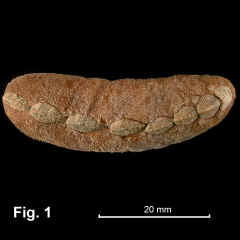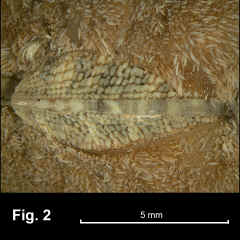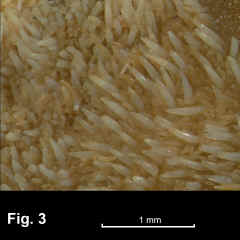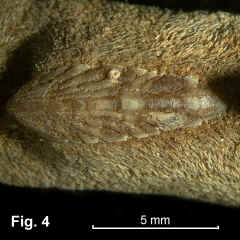|
|
CRYPTOPLACIDAE |
|
|
|
Cryptoplax striata (Lamarck, 1819) Description: Animal elongate, with relatively small valves embedded in a wide girdle; valves in contact in juveniles, usually separated in adults. Valves sculptured with about 5 rows of nodules or ridges either side of smooth jugum (Fig. 2). Girdle covered with pointed, curved spines (Fig. 3). Valve colour fawn, reddish brown, grey or yellow. Girdle yellow to brown. Size: Up to 100 mm in length in SA, much smaller in NSW. Distribution: Endemic to Australia: southern Qld southwards and around southern Australia to south-western WA. Habitat: Under stones below low water mark, and in worm holes and crevices in soft rock (Iredale & Hull, 1927, p. 94). Comparison: This species is similar to Notoplax speciosa in the Acanthochitonidae, in having small separated valves embedded in a spiculose girdle, but Notoplax speciosa has an ovate body shape in contrast to the elongate form of Cryptoplax. Synonymy: Cryptoplax mystica Iredale & Hull, 1925 is recognised here as a synonym of Cryptoplax striata (Lamarck, 1819) (NEW SYNONYM) Remarks: Cryptoplax striata shows variation in shell sculpture over its range. The NSW form (Fig. 2) has a sculpture of regular pustules, but shells from southern Australia show the pustules merged into irregular ribs, as in the specimen from Phillip Island, Vic. (Fig. 4). Iredale & Hull (1925) named the NSW shell Cryptoplax mystica, based on "the broad valves and the lozenge shaped nodular sculpture", but I prefer to regard it as a sculptural form of a single species that occurs from southern Qld to south-western WA. Fig. 1: Long Reef, Collaroy, NSW (C.367438). Fig. 2: Detail of valve VI. Same specimen as Fig. 1. Fig. 3: Girdle spines. Same specimen as Fig. 1. Fig. 4: Detail of valve VII. (Phillip Island, Vic. C.175573). |
|



